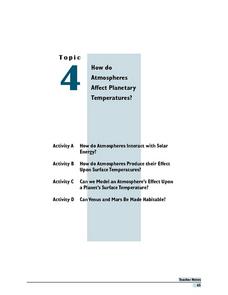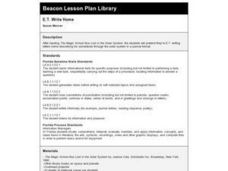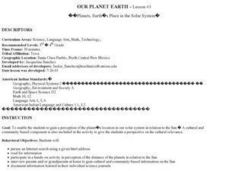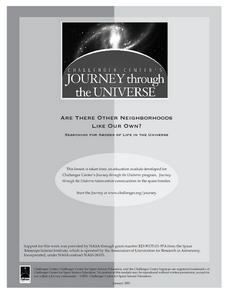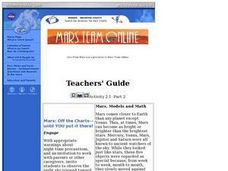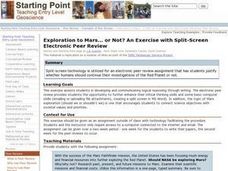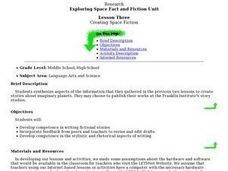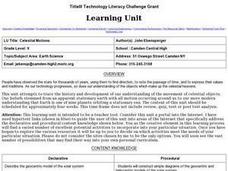Curated OER
Exploring the Universe
Students conduct Internet research to find information about each planet and present their findings to the class. Students research statistical information and two interesting facts about each planet, then create a multimedia...
Curated OER
Voyage to Titan
Learners go to the linked web page "The Nine Planets" to find facts about Titan. They list elements of the solar system and the five planets of the outer solar system. Students find their weight on each planet. Titan is selected from the...
Curated OER
Mars Colonization Assignment #1
Eighth graders recognize the some day humans may wish to colonize Mars. They participate in an Internet adventure where they compare and contrast Earth to the other nine planets in the solar system.
Curated OER
Space Trader and Economics
Students use handheld computer with the appropriate software to explore economic skills. They purchase and sell items, travel to planets, and earn enough money to purchase a moon by playing a computer based game.
Curated OER
Space - In Your Face or Not?
Second graders, in groups, examine how it doesn't matter if they can see the planets in the solar system or not--they're there.
Curated OER
Reaching the Solar System
Students sing the Rap of the Solar System, view pictures of the planets, and calculate their weights and ages on all the planets and the sun. They create a presentation comparing themselves with a planet or object in the solar system.
Curated OER
Solar System Distance Activity
Learners examine the distances between the Sun, planets, and smaller objects in the Solar System. They design a model using beads that shows the scale distances of the Solar System using astronomical units converted into a 10 centimeter...
Curated OER
How Do Atmospheres Affet Planetary Temperatures?
Students perform a literature search and use reputable research resources in order to find the surface temperature of different planets in our solar system. They speculate about the observed and unobserved factors. Then brainstorming is...
Curated OER
Outer Space and Beyond
Young scholars compare and contrast the size, characteristics, composition, and orbits of the planets in our Solar System. They view a PowerPoint presentation, and in small groups conduct Internet research on a selected planet. Each...
Curated OER
Spacing Out the Solar System
Sixth graders practice applying their problem-solving skills as they measure circular objects and make connections to planets. They identify and describe measurable attributes of objects and units of measurement and solve problems...
Curated OER
E.T. Write Home
Students read the book, The Magic School Bus Lost in the Solar System, and discuss the planets visited by the characters in the book. They write journal entries from the viewpoint of E.T., writing letters home describing his travels in...
Curated OER
Earth's Place in the Solar System
Students study and discuss the planets. They create a visual representation of the layout of the solar system and color it. They also write an informative/narrative summary report on the cultural relevance of the Sun.
Curated OER
Are There Other Neighborhoods Like Our Own?
Learners investigate the possibility of life existing on other planets. They conduct research using a variety of resources. The lesson includes an overview that is used for classroom discussion practices. They tell the teacher how to...
Curated OER
Mars: Off the Charts--Until You Put It There
Learners explore the night sky and make illustrations which are shared in class the next day. Distinctions are made between the stars and the planets and views of the constellations for the season are made available. The work of early...
Curated OER
A Star Party
Students explore the parts and function of a telescope. In this investigative lesson students gain an understanding of a telescope and identify planets and constellations.
Curated OER
Retrograde Motion of Mars
Middle schoolers investigate the motion of Mars. In this space science lesson, students use transparencies to trace the path of Mars through constellations. Middle schoolers discuss the characteristics of the planet.
Curated OER
Solar System Bead Distance Activity
Middle schoolers create a scaled solar system model using colorful beads. In this space science instructional activity, students convert AU units into metric measurements. They arrange the planets according to their distances from the sun.
Curated OER
Solar System Lesson Plan
Students explore the internet to answer specific questions about the solar system. They use worksheets to record information about planets. Students increase awareness of the solar system through exploration of websites.
Curated OER
Concept Application: One to One Correspondence of Objects
Learners consider the comparative sizes of the planets in the solar system. In this scale instructional activity, students select balls of different sizes to represent the planets in the solar system.
Curated OER
Exploration to Mars... or Not? An Exercise with Split-Screen Electronic Peer Review
Students use split-screen technology which is utilized for an electronic peer review assignment that has students justify whether humans should continue their investigations of the Red Planet or not.
Curated OER
Orbital Motion
Students use a formula to measure the eccentricity of an ellipse, then state Kepler's Law of Elliptical Orbits. They predict the solar energy received at different positions in a planet's orbit.
Curated OER
Exploring Space Fact and Fiction Unit: Creating Space Fiction
Young scholars create stories about imaginary planets.
Curated OER
Celestial Motions
Ninth graders complete a unit of lessons on the history of our knowledge of celestial objects. They conduct Internet research, plot the motion of a planet, construct a model of the sun's apparent motions, and create diagrams of the solar...
Curated OER
Planet Paths: Studying Planetary Orbital Paths
Students define and identify planetary orbit, ellipse, parabola, and hyperbola, and simulate Kepler's Second Law. They explore interactive websites demonstrating orbital motion and complete modeling activities.









